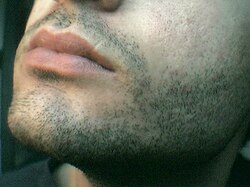
Designer stubble is a facial hair style which is a short growth of beard, aimed to affect a rugged masculine or deliberately unkempt appearance. [1] In the late 20th century, it was popularized by singer George Michael [2] and actor Don Johnson. [3] Several companies now manufacture beard trimmers designed specifically to maintain the designer stubble look. [4] Typically created by trimming the beard to a length of 1–3 mm, designer stubble is roughly three days of growth, in contrast with the shorter "five o'clock shadow". [5]